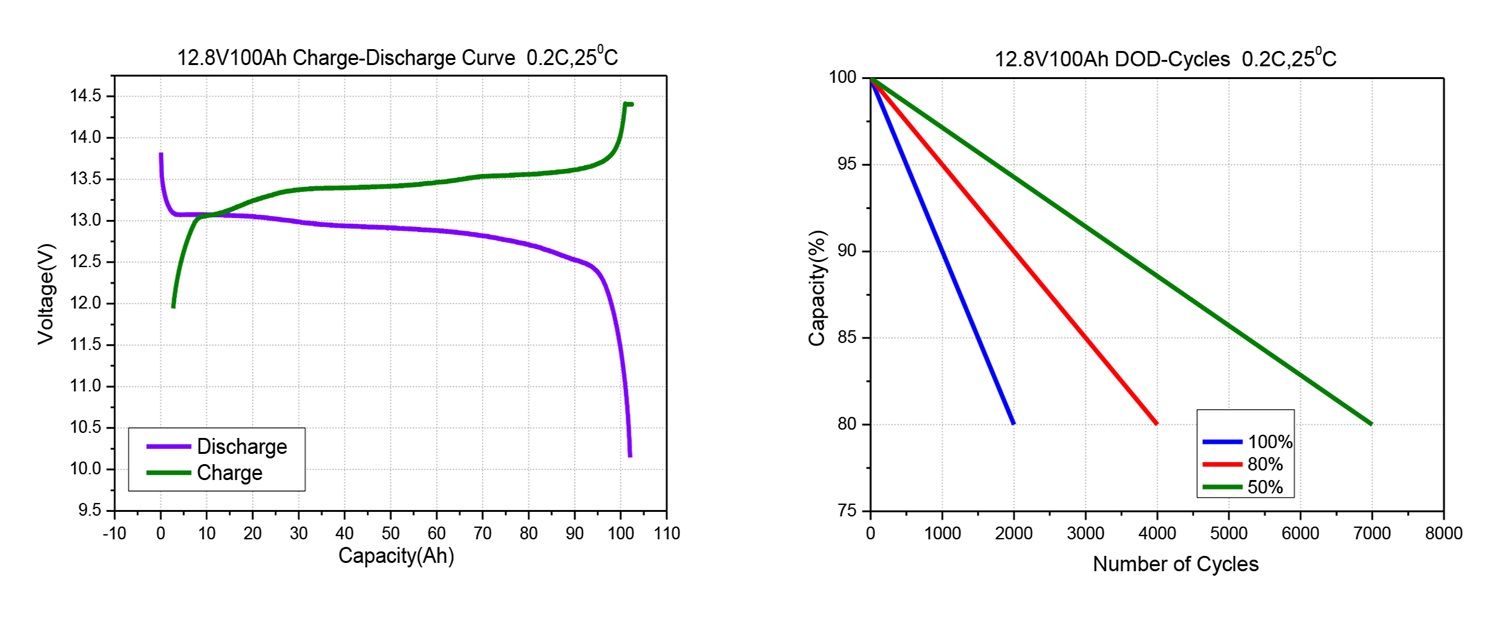12V 100Ah Battery Pack Parameters
|
Items
|
Parameter
|
|
Product Model
|
4IFR12.8-100-Y(26650-3.2V-4S32P)
|
|
Normal Voltage
|
12.8V
|
|
Rated Capacity
|
100Ah(C5)
|
|
Min Capacity
|
97Ah(C5)
|
|
Energy
|
About 1280Wh
|
|
Internal Resistance
|
≤45mΩ
|
|
Size
|
£¨327±3£©mm *£¨172±2£©mm *£¨234±3£©mm
|
|
Weight
|
13.8±0.3kg
|
|
Charge Voltage
|
14.4±0.15V
|
|
Standard Cutoff Voltage
|
About10.0V
|
|
Charge Current
|
≤20A
|
|
Charging cut-off current
|
1A~2A
|
|
Discharge Current
|
Normal Current≤40A
|
|
Passive Protection
|
Over charge protection, Over discharge protection, Temperature protection, Balanced function
|
|
Positive
|
M8 hole
|
|
Negative
|
M8 hole
|
|
Charge Retention
|
After charging according to standard 3.2, placing the battery for 28 days under the standard test conditions, then discharge it under standard 3.3, and the charge retention rate is ≥80%.
|
|
Cycle time
|
The cycle life is not less than 2000, the capacity retention rate is ≥80%. (Charging according to 3.2 standard, leaving 0.5~1h; discharging according to 3.3 standard, leaving 0.5~1h, counting 1
cycle time)
|
Characteristics Curve Of The 12V 100Ah LiFePO4 Battery Pack
Battery Usages
Charge
Charging terminal of battery is connected to charger appropriate with it, and then charge. Charging voltage is14.4±0.15V. Do not reverse.
Discharge
Note that the positive and negative (poles are not reversed as indicated by the battery case logo), then connect to the matching load.
Battery Test
Single cell and Protection board specification are only results of standard test, this is for reference.
Standard Test Requirements
Battery tested must be done within 1 month after production. If the battery is not tested on time due to transportation or other reasons, the battery can be recharged and discharged for testing. All tests in this specification should be done in standard atmospheric conditions. (Temperature: 25± 2¡æ; relative humidity: 65± 20%).
Standard charge voltage is 14.4±0.15V, standard discharge cutoff voltage is about10.0V; standard current is I5 (when I5 > the normal work current, test according to the normal current).
Standard Charge
Charge the battery with Lithium ion battery special test cabinet, with standard charging voltage, standard current, constant current and constant voltage charging to the current dropping to 0.05 I5·
Standard Discharge
Discharge the battery with Lithium ion battery special test cabinet, discharge to standard discharge cutoff voltage with standard current, constant discharging or until the battery stops.
Battery Service Environment
Battery discharge ambient temperature is -20¡æ~+60¡æ, humidity: RH¨Q85%. When the ambient temperature >45 ¡æ, please pay attention to the ventilation and heat dissipation, pay attention to waterproof when ambient humidity is > 85%, at the same time the battery surface condensation phenomenon should be avoided. Charging temperature 0 ¡æ ~ + 45 ¡æ,
humidity: 85% RH or less, pay attention to waterproof when ambient humidity is > 85%.
Special Attentions
In order to make full use of the energy efficiency of the battery and prevent accidents such as leakage or heat generation, please prohibit the followings;
¡ñ Do not immerse the battery in the water. Once it is in the water, isolate it immediately and ask a professional to deal with it.
¡ñ Do not charge, discharge and leave the battery at temperatures over 60¡æ. Also keep away from fire, heater or corrosive materials. Otherwise, it can cause overheat, fire, or function failure, shortened life, or even danger happening.
¡ñ Do not charge the battery at temperature below 0¡æ.
¡ñ Do not reverse the positive and negative terminals. Do not short the positive and negative of the battery.
¡ñDo not combine the battery in series or in parallel.
¡ñ Do not reverse polarity charging. Do not connect the battery electrodes to an electrical outlet.
¡ñ Do not transport or store the battery together with metal objects such as hairpins, necklaces, etc.
¡ñ Do not strike, trample, throw, fall and shock the battery.
¡ñ Do not directly weld the battery and pierce the battery with a nail or other sharp objects.
¡ñ Do not use the battery in the location where static electricity and magnetic field is strong. Otherwise the battery protection circuit may be damaged.
¡ñ Do not overload the battery.
¡ñ Do not machine the circuit board, which may damage the internal circuit and cause function failure.
¡ñ Do not deform the product under pressure, which may cause electronic components or part of the circuit damage, and
make the product unstable.
¡ñ Do not remove the case, in case of unnecessary damage.
¡ñ Do not overcharge or over discharge the battery.
¡ñ Please use special charger for charging.
¡ñ Please charge the battery within 12 hours after using. If the battery is not charged for more than 12 hours after using, please test the battery voltage before charging. If the voltage of the battery is < 8.0V, do not charge, need to place in isolation. Meanwhile please contact our technical staffs.
¡ñIf the battery leaks and liquid splashes into the eyes or skin, do not rub, wash it with clean water, and immediately seek medical attention.
¡ñ In case of accidental fire, dry powder fire extinguisher or sand should be used.
¡ñ If the battery gives off strange odor, generates heat, becomes discolored or deformed, or any abnormality appears during use, storage, or charging, stop charging and using immediately, remove and isolate it from the device in the safe way.
¡ñ The electrode of the discarded battery terminal should be covered with insulating paper to reduce the safety hazard when laying aside.
¡ñ Reversing the Positive and negative charging terminal will burn the internal circuit board, so pay attention to it.


